The Panasonic Lumix GF-1, and pondering the photography needs of a food blogger
(Hi everyone. As Guruman posted, I was hospitalized for emergency surgery 2 weeks ago, and I'm still in hospital unfortunately. So there won't be any new recipes from me for the time being. However, I still have lots of topics from my Japan trip to talk about. Here's an article I was working on before I had to go to the doctor, and I was able to finish it up today finally. I'll try to be back to full throttle real soon!)
Back in March, I got a new camera in Tokyo; the <a href="Panasonic Lumix DMC-GF1. I think this one just might be the ideal camera for many food bloggers who are looking to upgrade their point-and-shoots, or for a lighter alternative to a DSLR. Here's a review of the micro four-thirds format itself and this camera in particular. It's not a very technical review - there are plenty of those online elsewhere. Instead it's focused on the photography needs of a typical food blogger.
Back in the olden days - say, prior to 2005 - photography was not necessarily a high priority for food blogs. These days of course that has changed drastically. So many food blogs feature gorgeous, mouthwatering photography these days that if yours doesn't, you may feel a bit left behind.
Since starting Just Hungry back in 2003, I've gone through a number of digital cameras. Last year, as the photographic needs of Just Hungry and Just Bento got to a critical point, I splurged on a serious DSLR - a Nikon D700, together with two Nikkor lenses (a 50mm and a macro lens). The purchase of this kit burned a serious hole in our household budget, but we justified it between us since The Guy (aka Guruman) could also use it for his photography (he is into train and architectural photography, and still has a Hasselblad that he hauls out on occasion for serious film shooting). I also carried around a compact point and shoot in my handbag - a Sony DSC-W300. For a while, I was pretty happy with this combination. But still, there were disadvantages to both. Before I get to those though, let's take a look at...
For what situations does a food blogger need a camera for?
Every food blog is different of course, but they do share some common needs when it comes to cameras. We need them for one or more of these situations:
- "Studio" shots at home, of food we make, more often than not to accompany a recipe. The studio may just be your kitchen counter or dining table or a window sill with bright light, but you have a fair amount of control over lighting conditions and such, and some time to set up a shot.
- Shots of food in restaurants, especially if you're a food blogger who posts a lot of restaurant reviews, or just like to post shots of memorable meals eaten out. You rarely if ever have control over the lighting and such in these situations. Many times a restaurant is very dark.
- Shots of food and more in other situations, at markets, stores, at the farm, or what have you. Again, you don't have control over lighting and such, and you need to shoot quite quickly in most cases.
- General photography of landscapes, people and so on, which may or may not be related to food or your blog.
A full size DSLR is great for the first situation. For the best shots, I use my DSLR with a tripod, available diffused light or studio lighting - a subject about which I still have a lot to learn. It takes time to set these shots up, so it's good when I have the time to spare, and ideal if I'm shooting more than one subject at a time.
But for the other situations it's not really ideal. First of all, it's really heavy; carrying it around for hours gets quite old, especially if you are a weakling with poor upper body strength like me. It's also rather obstrusive, especially in a restaurant setting, with its bulk, big lenses, and loud shutter noise. You may not mind when other diners glare in your direction as you shoot away at your food, but - well, it does bother me rather.
A good point-and-shoot compact camera, or a cellphone with a good built in camera, is great for on-the-road shooting, in terms of its size (fits into a pocket) weight (almost nothing) and general unobtrusiveness (the shutter noise is digital, not mechanical, so you can turn usually it off for totally silent shooting). But there are disadvantages, such as the inevitable shutter delay and the general lack of control over your shooting settings.
Enter the micro four thirds format
Micro four thirds format cameras are basically miniaturized DSLRs - small cameras with big sensors. The size of the sensor is the biggest difference between a DSLR and a point and shoot, and what makes DSLR photos just that much richer and deeper. Micro four thirds cameras have smaller sensors than DSLRs but much bigger sensors than compact cameras. They also have interchangeable lenses. They lack the full features of a big DSLR, but for me, these are more than compensated for by their small size and light weight. (See the Wikipedia entry for more about the micro four thirds format.)
Micro four thirds cameras available at the moment from Olympus (the EP or PEN series) and Panasonic (the Lumix G-series). I wanted to get one in Japan, where camera equipment is bit cheaper than in the U.S. and considerably cheaper than in Europe. After reading pages and pages of reviews in both Japanese and English, I went with the GF-1 over the Olympus PEN. I got it shortly before I went to Kyoto back in mid-March, and I'm so glad I did. I'm in love with this little camera. Mine is in "Urban Red": colored bodies are only available in Japan I believe; other available colors include white, silver and pearly pink. Elsewhere (or at least in North America and Europe) you can just get the basic black model.
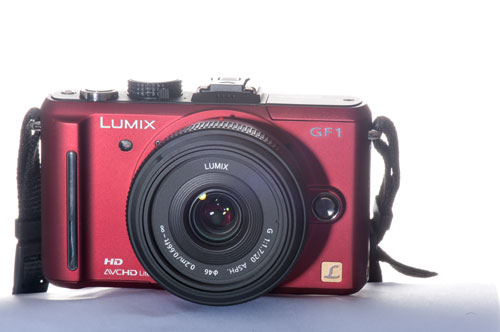
The camera body of the GF-1 measures 5 x 10 x 7 inches (36mm x 119mm x 71mm) 4.68 x 2.79 x 1.43 inches (119 x 71 x 36.3mm) (dimensions corrected - don't rely on what Amazon says!). It comes with a choice of one of two kit lenses, a 14 - 45 mm f/3.5 - f/5.6 zoom lens, and a 20mm f/1.7 aspherical "pancake" lens. I wasn't sure which one was better to have, so I got the camera with the "pancake" lens, and purchased the zoom lens separately. However, in the 4 months or so that I've had the camera, I've only used the zoom lens a few times. The pancake lens is just terrific for my needs - it's superfast, letting me take great pictures in low light conditions. It's also very compact and lightweight, and just feels like an integral part of the camera. The zoom lens makes the little camera body feel unbalanced. The "pancake" lens is a fixed focus lens, which may take a little getting used to if you're used to zooming in and out all the time, but it wasn't a bit deal for me since I don't zoom that much anyway. It just means you have to physically move to get the right shot.
Most of the photos taken for the recent Postcards from Kyoto series of posts were taken with the GF-1, using the pancake lens. When I'm out and about and walking around, I almost exclusively use the "intelligent auto (iA)" setting. When I have a bit more time to shoot I do try the other settings.
One other advantage of the GF-1 is that it can save photos on RAW format, which is ideal for editing later on in Photoshop, Lightroom and so on.
The GF-1 + aspherical lens for shooting food
When you use the GF-1 with the 20mm "pancake" lens, it's easy to take the shallow depth of field type of food shot that is popular these days, where the area in focus is limited and the background is blurred. In addition, the lens is so fast that you can shoot photos of food under all but the lowest light conditions, and it comes out looking great. The shallow depth of field can be a drawback for some shots, so I needed to work around it a bit, but for more food closeup shots it works quite well.
Some un-post-processed food photos taken with the GF-1
All of the example photos below were taken with available light, and have not been post-processed in Photoshop and so on in any way, except to crop and resize them down for web publishing. Note that I didn't exactly try to style the food beforehand either, and for a regular blog post I might post-process some of the photos a wee bit. But here I just wanted to show what the camera can do in various light conditions. You can look through my recent flickr uploads for more examples.
This was a simple dish of panfried chicken and boiled asparagus with pasta that we had for dinner one night. The photo was shot just with the light from two halogen floor lamps.
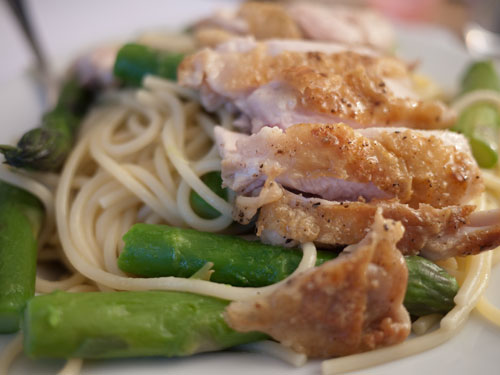
The following photos also taken at night, under a plain pendant lamp with a 100W incandescent bulb.
Chicken karaage (fried chicken):
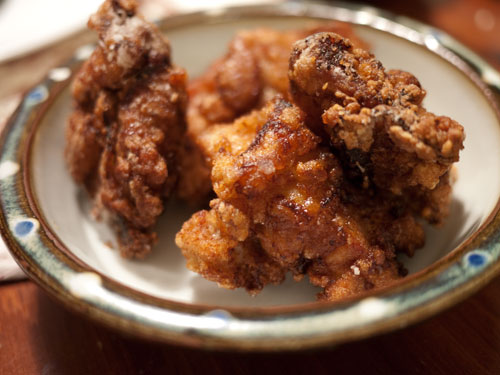
Hiyayakko (cold tofu), a staple of summer:
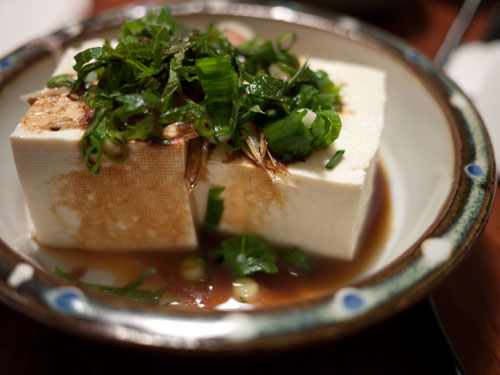
This photo was taken in a windowless hotel dining room, under some rather dim, shaded flourescent lights:
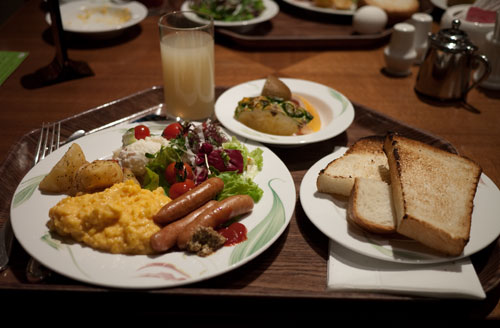
This photo of a steamed bun (from my favorite steamed bun place in Yokohama...or the world...oh I want one NOW...uh, where was I) was shot under a fairly bright flourescent light:
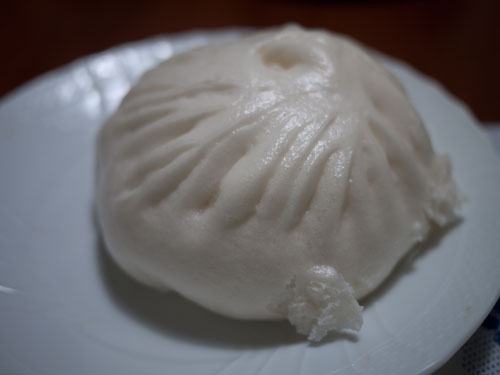
These 7-11 konbini sandwiches were shot during the day, on a table that's about 15 feet away (5m) from a large south-facing window:
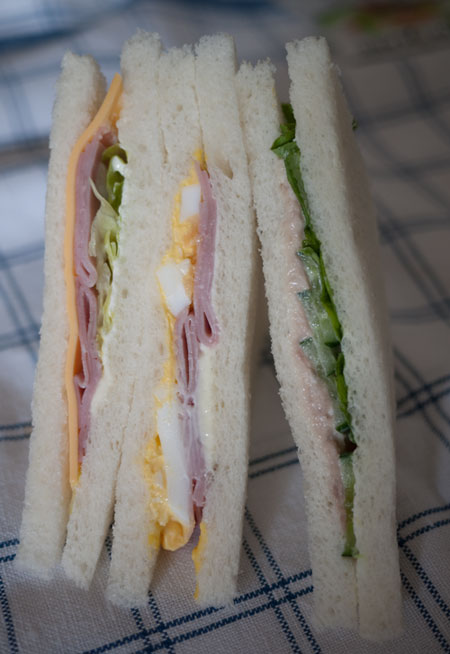
This sushi bento photo was taken in the Shinkansen bullet train, in the late afternoon, using light from the window:
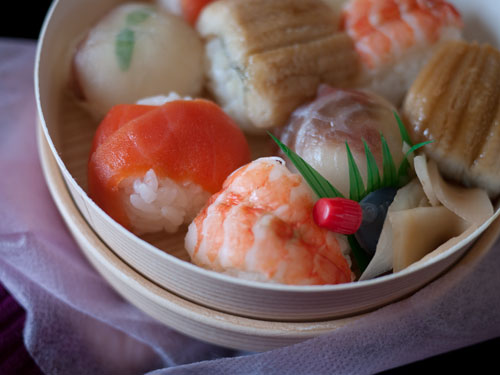
The peaches were shot in the early evening (around 7pm), near a north-facing window:
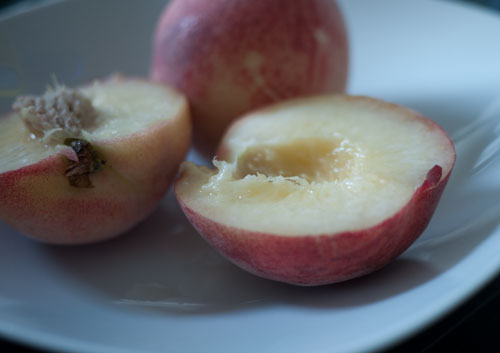
This was taken at a soba restaurant, some 20 feet or so away from the shoji screened front windows:
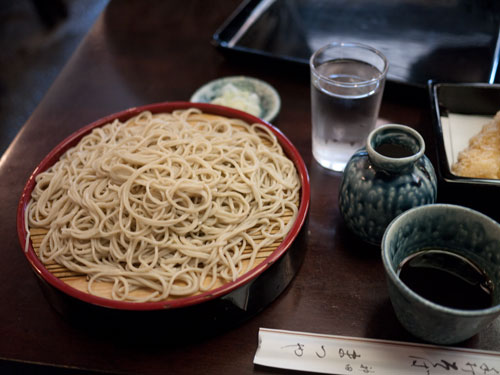
This was taken in tree-filtered sunlight in the early afternoon, as The Guy walked out of a bakery:
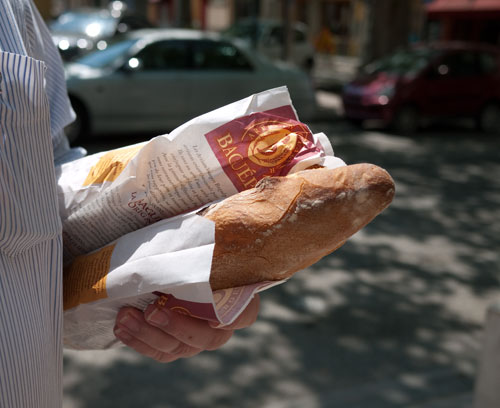
And finally one non-food shot, though still in a restaurant: my niece and nephew with Chef Mickey, in a restaurant that has no windows facing directly outside. The lights are a combination of flourescent and incandescent (I think) with glass shades:
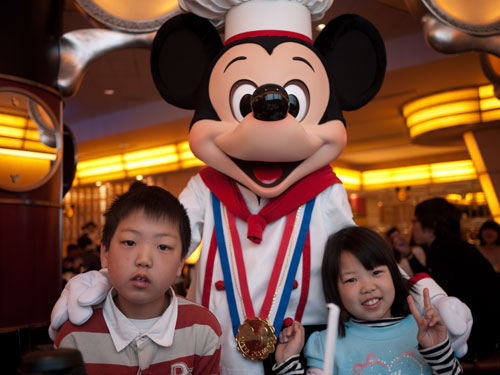
Pros and cons of the micro four thirds format
Micro four third format cameras may not be for everyone. For one thing they are quite expensive - you can pick up an older DSLR model for cheaper, not including the lenses. If you don't mind lugging around a heavy DSLR body and big lenses, then a full size DSLR is what you want.
The GF-1 is quite compact, but it's not small enought to carry in your pocket. (If you want a compact point and shoot that can save photos in the RAW format, you should look into the Canon PowerShot S90, which I almost went for myself.) The GF-1 does not have a viewfinder, so you have to rely on the monitor. And the viewfinder attachment, a separate purchase, is not really worth getting in my opinion, since it adds bulk to the camera and is low resolution. Finally, the GF-1 does shoot video, but is rather limited in that respect. It's not the camera for you if you are looking for a all-in-one solution for video and still photography.
Still, for me the weight, compactness, and versatility of this camera is well worth it. I usually have the GF-1 in my shoulder bag, which I have with me all the time - the camera stuff takes up half of the bag, and I put my wallet and so on in the other half. It is light enough for me to be able to have it with me all the time. And I just love that fast little "pancake" lens. Carrying the D700 around with me like this would just not be possible.
Anyway, if you're a food blogger considering a camera upgrade, or just in the market for a new camera, I'd heartily recommend giving the Panasonic Lumix DMC-GF1 a look!
Incidentally, in Japan micro four thirds format cameras are being marketed quite heavily to women - the female amateur photographer who wants to move up from a point-and-shoot. This accounts for the variety of colored bodies I think. Men love it too though; these are serious cameras after all, but lightweight enough to have with you all the time.
Notes: Buying camera equipment in Japan
I mentioned that Japanese cameras are a bit cheaper in Japan, and you get the option of buying them in those pretty colors that they don't sell overseas. If you are considering purchasing a camera in Japan though, ask the seller if the language can be switched from Japanese. My GF-1 only has Japanese menus and so on, which is not an issue for me of course, but could be for you. The language thing is not an issue with accessories like lenses though. If you are a girly type, you can also find all sorts of cute accessories for your camera, such as pretty camera bags and straps. Manuals can be downloaded in several langauges from the vendors' websites.
(Standard disclaimer: I bought the camera and all accessories with my own money, and these are my honest opinions, for which I'm not being compensated in any way.)
If you enjoyed this article, please consider becoming my patron via Patreon. ^_^

 Welcome to Just Hungry, where we serve authentic Japanese recipes and more! I'm
Welcome to Just Hungry, where we serve authentic Japanese recipes and more! I'm 














Comments
wintersweet
18 July, 2010 - 18:51
Permalink
Re: The Panasonic Lumix GF-1, and pondering the photography ...
Beautiful photos, though that's largely about your skill! It does perform beautifully in all kinds of light, though...
I have a basic p&s Panasonic Lumix, partly because I was impressed that a more entry-level camera would have a Leica lens. It does pretty well. I'll have to see if there are any food photos on my cards now or if I'd offloaded them onto my previous laptop just before it was stolen. I can't upgrade to that model when/if I go back to Japan, but I do want to practice taking food photos before I go back! I got a couple of good ryokan kaiseki photos last time with my previous camera, but that was dumb luck and a cooperative camera that's no longer manufactured.
Anyway, I hope you're recovering well. I've spent part of each of the last three summers in a different hospital (helping a friend recover from a surgery that became unexpectedly complicated, my own emergency, and now helping my dad recover from surgery). It's really miserable.
I hope that French hospital food is better than American (or what my friend says about Japanese, for that matter). Or maybe you're doing well enough that Guruman can bring food in.
Train photography, eh? That's something I want to try next time, too, I confess. (Oh, the geekery runs deep in me. Eep!)
Take care!
--
http://www.readableblog.com (for English learners)
http://www.talktotheclouds.com (for teachers)
Guruman
22 July, 2010 - 23:11
Permalink
Re: The Panasonic Lumix GF-1, and pondering the photography ...
To inspire wintersweet, Guruman has a humble Flickr photostream with mainly railroad photographs: http://www.flickr.com/photos/pdfguru/
Chris
18 July, 2010 - 20:25
Permalink
Re: The Panasonic Lumix GF-1, and pondering the photography ...
I bought a Sony DSC-HX5V on amazon.co.jp just last month. It is a compact high zoom camera. I love it because of its all-round capabilities such as 1080p video recording and gps for auto geo-tagging. As you mentioned in the article the menu is all Japanese and you cannot change it. As far as I know Canon is the only manufacture which allows that. Nevertheless with the English manual and knowledge in Hiragana / Katakana you can figure out most of the controls ;-).
The best thing about buying cameras in Japan is the price. I almost saved 200 Fr. (~190$), even including the shipping costs and transaction fee of tenso.com .
Clarisse
18 July, 2010 - 21:14
Permalink
Re: The Panasonic Lumix GF-1, and pondering the photography ...
I bought this camera too a few months ago, and when I went to Japan I brought it along for its first shoot. It was wonderful (though Japan's natural beauty certainly helped) and it's such a great weight and size (especially for girls!). It gets you some street cred as someone getting serious about photography without the DSLR bulk. And the shutter click is so cute!
Generally, I would think that electronics in Asia are generally cheaper. I considered purchasing the camera in Japan itself, hearing that the prices would be lower than whatever I paid for in Singapore, but I couldn't wait and decided to buy it before my trip — thank goodness I did, because while the GF1 body was cheaper, the lenses were more expensive, and in the end it worked out to be the same as what I paid back home.
Mine is a white model and I love it, but your red one looks delicious too. Most camera stores in Singapore seem to stock coloured versions of the GF1 too, so perhaps the limited colour is a European-American phenomenon?
Athena
18 July, 2010 - 22:25
Permalink
Re: The Panasonic Lumix GF-1, and pondering the photography ...
I'm glad you posted this. I've always vaguely wondered about the sort of "behind the scenes" stuff that goes on with a blog like Just Hungry or Just Bento. I've taken pictures with my camera phone of bentos I've made to show other people what I mean when I talk about filling empty spaces, and they always turn out looking so unappetizing. It's not a big important thing for me that they look awesome, but it's made me stop and think, "Well, then how does Maki make all her bentos look super awesome? Is is the lighting? Difference in camera? Mad skillz?"
I hope you're getting well! Even non-recipe related posts are still better than no Maki posts at all! =D
M
19 July, 2010 - 04:21
Permalink
Re: The Panasonic Lumix GF-1, and pondering the photography ...
I own a Lumix p&s and it's great, I chose it mostly because of the quality of the images vs the other brands I looked at, the GF1 seems great for an upgrade!
BTW get better soon!!!
xx
Angeleyes
19 July, 2010 - 06:57
Permalink
Re: The Panasonic Lumix GF-1, and pondering the photography ...
Thank you so much for putting up this review! I am looking to get a DSLR too but heard about this Panasonic Lumix and wonder how good it is.
I think I gotta go to the shop and check this little baby out and see if it really suitable for me.
Cheers and get well soon! :D
momgateway
19 July, 2010 - 07:16
Permalink
Re: The Panasonic Lumix GF-1, and pondering the photography ...
Sorry to hear about your emergency surgery and hope you'd be in the mend soon. I've been thinking of getting myself a new camera too for close-ups but right now both Panasonic Lumix GF-1 and Canon PowerShot S90 are still too pricey for me. Thanks for the very informative post.
ruskie
19 July, 2010 - 07:41
Permalink
Re: The Panasonic Lumix GF-1, and pondering the photography ...
Hmm nice to see the 4/3 format spreading around. I've got a normal 4/3 DSLR and am very happy with it. They are the most compact and versatile DSLRs around. I've been thinking of getting a micro 4/3 just to have something that I can always have in my pocket but the cost is rather prohibitive.
Really nice write up on how it handles in various areas(with a skilled photographer that is but then I would assume most any camera to work that way in such hands).
I prefer Olympus gear though to Panasonic. Simply because they have that great Digital Zuiko glass(though with 4/3 it should be possible to use on any 4/3 and with an adapter on a micro 4/3 as well).
Elise Bauer
19 July, 2010 - 08:33
Permalink
Re: The Panasonic Lumix GF-1, and pondering the photography ...
HI Maki,
"The camera body of the GF-1 measures 5 x 10 x 7 inches (36mm x 119mm x 71mm)"
hmm, that would be HUGE. Like a large, thick book.
The inch conversions for those mm measurements are:
1.4 x 4.6 x 2.8 inches
Thanks for your review, btw. I'm thinking about getting one based on your recommendation!
maki
19 July, 2010 - 09:20
Permalink
Re: The Panasonic Lumix GF-1, and pondering the photography ...
Hi Elise, you're right! I used the numbers they had on the Amazon.com page, which are pretty wrong. Corrected now to hopefully now accurate numbers! (I'd measure it myself but I don't have it here at the moment)
Ryeblossom
19 July, 2010 - 19:25
Permalink
Re: The Panasonic Lumix GF-1, and pondering the photography ...
Get well soon! (^_^)
The pictures look good and yummy, no matter the lighting. That's pretty impressive.
Debs
19 July, 2010 - 21:35
Permalink
Re: The Panasonic Lumix GF-1, and pondering the photography ...
I have one, and I love it!
mitsi
21 July, 2010 - 05:14
Permalink
Re: The Panasonic Lumix GF-1, and pondering the photography ...
Awesome!!!!!!!
I have always wanted a DSLR but the price range is waaaaaaaaay too high for me.... this would be perfect... and I am lazy so smaller is better too. The pictures your have posted here - with the pacakes lens? or the zoom?
Can you still use the camera's digital zoom with the pancake lens?? Or is there just no zoom what so ever with the pancake lens????
Hope you get out of hospital soon - your wound is awesome btw.!
maki
21 July, 2010 - 07:03
Permalink
Re: The Panasonic Lumix GF-1, and pondering the photography ...
I took all the photos I posted with this article with the GF-1 (well, except for the photo of the GF-1 itself of course ^_^) using the pancake lens. There is no digital zoom in the camera - full size DSLRs don't have digital zoom either. The zoom lens is a manual zoom that you operate with your hands.
mitsi
21 July, 2010 - 09:56
Permalink
Re: The Panasonic Lumix GF-1, and pondering the photography ...
OK - Now I am confused... well, no i get what you are saying, but does the pancake lens have no zoom on it at all??? (Sorry to be a pain!)
maki
21 July, 2010 - 13:22
Permalink
Re: The Panasonic Lumix GF-1, and pondering the photography ...
That's right - it's a fixed focus lens, so no zoom. I know it may sound limiting, and it takes getting used to, but most professional photographers and serious amateurs use fixed focus lenses for most things.
Guruman
22 July, 2010 - 10:01
Permalink
Re: The Panasonic Lumix GF-1, and pondering the photography ...
As Maki already said, the GF-1 does not have digital zoom.
But then, when you look at it, "digital zoom" is the same as when you are in the image processing software (Photoshop, The Gimp, etc.) and take a section of the image and scale it up to the full image size.
mitsi
21 July, 2010 - 16:12
Permalink
Re: The Panasonic Lumix GF-1, and pondering the photography ...
Cheers - I am a total n00b when it comes to anything not point and shoot and lens' and omg *dies*
Thanks for answering even though you're unwell - means alot.
By the way, love the blog :)
Tiny Urban Kitchen
21 July, 2010 - 18:02
Permalink
Re: The Panasonic Lumix GF-1, and pondering the photography ...
Glad to hear you are feeling better and I hope you get out of the hospital soon. It's so nice to hear from you!
I love love love my GF1 and most of my photos from my blog are actually taken with it. People think I use some fancy huge SLR (which I do occasionally) but typically I stick with the GF1 (with the pancake lens) because it works so well in restaurants, is small enough I carry it with me EVERYWHERE I go, and is fast! Love it!
Gemma
28 July, 2010 - 13:29
Permalink
Re: The Panasonic Lumix GF-1, and pondering the photography ...
Wow, I hope you are healing well and wish you the best of luck with your recovery. Thank you for taking the time while in the hospital to post this article on your Japan trip. It was really good.
IanG
5 August, 2010 - 16:36
Permalink
Re: The Panasonic Lumix GF-1, and pondering the photography ...
I just bought an 'open box' blue Panasonic DMC-G1 on ebay.com. Its a little bulkier than the GH1, but also a micro-four-thirds camera, and due to the newer G2 model, its selling for a good discount ($416 - $440 range). It comes with a zoom lens that is said to be more solid than that on the G2, and I believe it can accept the 'pancake' lens that you like - and I'm tempted to splurge on, too. It weighs about 1 lb 7oz, just a bit more than my Panasonic FZ-20.
Your shots look great, and I only hope mine will compare favorably to them. I'm a big fan of anything Panasonic, since I have had such good luck with their products.
Best wishes for your health - I hope you feel better soon.
mitsi
14 September, 2010 - 02:40
Permalink
Re: The Panasonic Lumix GF-1, and pondering the photography ...
I just bought one all thanks to you Maki!
Thanks for pointing out this wonderful camera to me!!!
Now to learn how to use it properly!! :D
Marikoeggplant
1 October, 2010 - 00:24
Permalink
Re: The Panasonic Lumix GF-1, and pondering the photography ...
I am seriously considering this camera and might buy it in Japan. Did you purchase yours from a chain store there? I am not sure what the best approach is these days. The yen is very strong compared to the US dollar right now, but even so the price listed on amazon's Japan site is better than I could get here (plus I wouldn't have to settle for the un-cute black!).
maki
1 October, 2010 - 00:31
Permalink
Re: The Panasonic Lumix GF-1, and pondering the photography ...
I got mine at Yodobashi Camera. Amazon prices are good too though, and by now they should have all the different colors (initially the pink, silver etc. ones were all sold out).
Daniel
25 March, 2011 - 20:34
Permalink
Re: The Panasonic Lumix GF-1, and pondering the photography ...
I just bought this camera not too long ago and I love it.. It's a great camera to just go around shooting anything.. It's worth every penny.